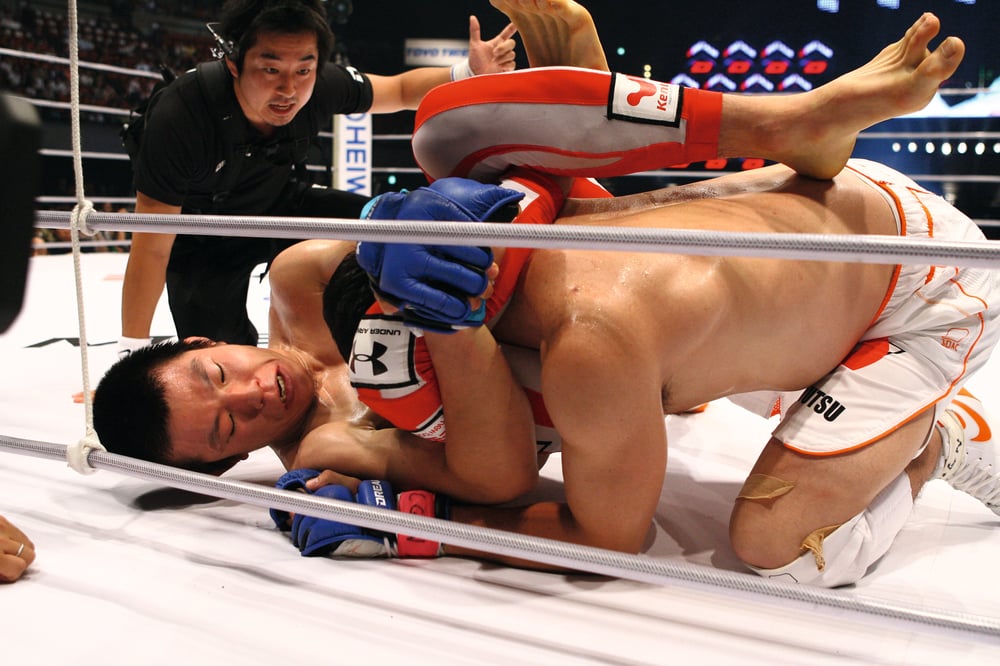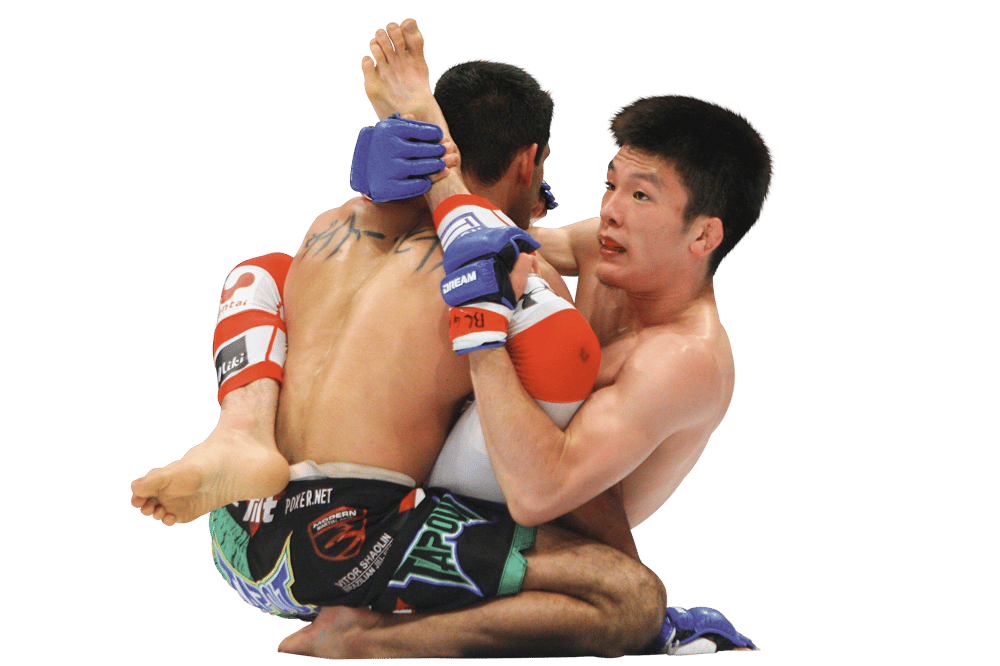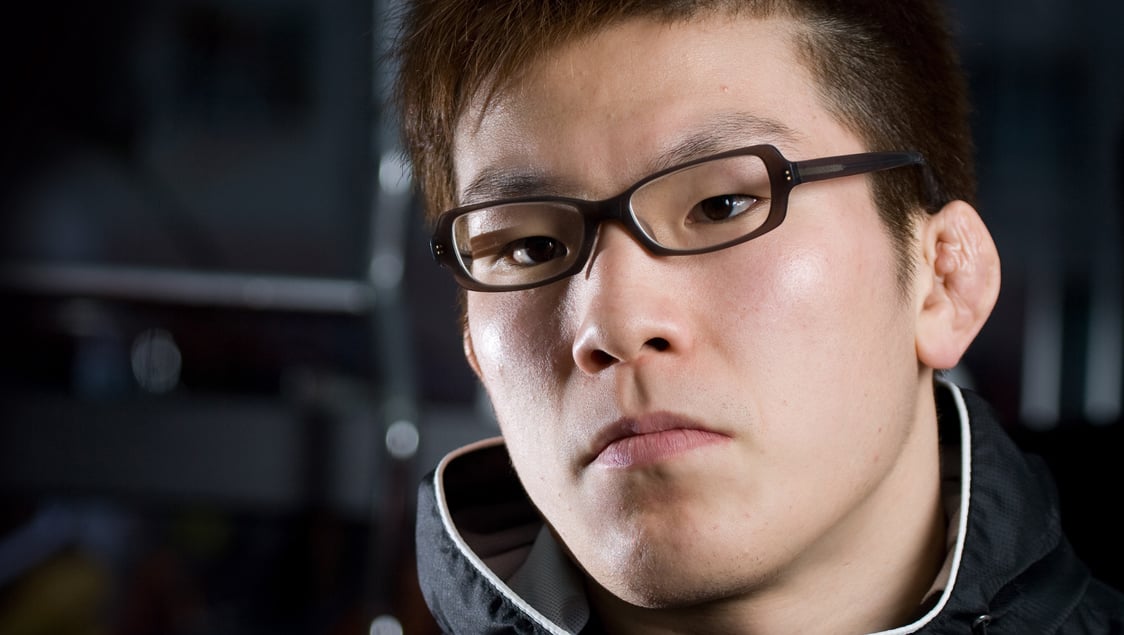
Issue 062
May 2010
The traditional image of the noble Japanese warrior: a stoic, emotionless face; a dignified stance; hard, rippling muscles; a single-minded will to never give up.
Enter Shinya Aoki, storming into the ring to the tune of the gloriously happy pop song ‘Baka Survivor’, his small boy’s face screwed up in a concentrated grimace, his hunched and wiry frame belying the staggering finishing power that has dispatched some of the finest lightweight fighters in the world. Not your typical Japanese fighter, then, but a superlative example of the highly talented grapplers manufactured in a country where judo training begins in elementary school.
First, let’s clear up Japanese naming conventions. Aoki is the family name and, in Japanese, comes first. It’s pronounced ‘ow’ as in ‘how’ and ‘key’ as in ‘keylock’ (the submission Aoki used to completely destroy Sengoku lightweight champion Mizuto Hirota’s shoulder at Dynamite!! 2009 – but we’ll get to that later).
A standout collegiate judoka, Aoki began training MMA and Brazilian jiu-jitsu under the watchful eye of Japanese MMA legend Yuki Nakai, the man who faced Rickson Gracie in the finals of Vale Tudo Japan in 1995. Nakai is generally considered one of the most important figures in modern-day Japanese martial arts, and he guided Aoki on his path to a black belt in BJJ and, later, a successful career in Japan’s homegrown and highly regarded MMA league, Shooto.
The young submission wizard had carried over the gymnastic athleticism prominent in the lighter weight classes of judo and developed a high-flying, aggressive submission game that often took more traditional BJJ players by surprise. In fact, he earned the nickname ‘tobikan judan’ (Tenth Dan in Flying Techniques).
Aoki was a fearsome competitor, entering every kind of jiu-jitsu and grappling contest on offer in his native Japan. He holds first-place medals from the All-Japan BJJ Championships, Ground Impact (G.I.) Professional Grappling 2005 (where he won three fights in a row via D’Arce choke), and won the ADCC Japan trials at under 76 kg. He even faced Roger Gracie and Marcelo Garcia in submission grappling.
Opponents slow to tap were often left clutching broken limbs. He isn’t the first fighter, Japanese or otherwise, to stand victorious while a downed opponent contemplates months of rehabilitation and possibly surgery – female standout Megumi Fujii and Aoki’s teammate Masakazu Imanari both have no qualms about taking a submission to its crunchy conclusion. Aoki claims “I’m not out to break anyone’s arm – the thing is, [they] don’t tap, so their arm’s broke.”
In the early stages of his career he planned to do a few fights in Shooto, finish his degree in sports science and go on to become a police officer. He imagined he would retire as a professional fighter to concentrate on ‘protecting Japan’ and training and competing in jiu-jitsu.
What happened so that Aoki now stands as one of the highest paid, most talented grapplers in the MMA world today? “Originally I wanted to be a policeman, yes. I thought it would be best for myself and my family. But the more I competed, the more I realized that I wanted to keep doing martial arts. Anyway,” he laughs, “I don’t think I could have really been a policeman.” What Aoki failed to mention is that he had a talent that was just too good to give up on.
Aoki made his debut in DEEP, a second-tier Japanese MMA promotion that nonetheless boasts some solid talent on its roster. He stormed through his first three opponents, leaving each of them nursing busted elbows, before running into Jutaro Nakao, a stalwart Japanese submission fighter with heavy hands to boot. In a flurry of punches in the dying seconds of the first round, Nakao came out on top and Aoki suffered his first defeat. Returning with a memorable bout at Shooto, Aoki ‘submitted’ American Keith Wisniewski with a particularly nasty standing armlock. Wisniewski didn’t actually have a chance to submit as Aoki trapped his arm and twisted violently, snapping the American’s elbow in the process. Aoki’s career moved from Shooto to Pride to Dream, where he now reigns as the lightweight champion. In fact, Aoki maintains an excellent professional fight record of 23 wins and only four losses.
Watching an on-form Shinya Aoki truly is a thing of beauty. He moves from one position to the next, python-tight, toward some unfathomable conclusion, the exact identity of which only he knows (but will probably involve his opponent tapping). Aoki has done things that nobody else has done in high-level MMA competition, from the standing armlock that shattered Wisniewski’s arm to the so-called ‘Aokiplata’ (see boxout). Does he see his talent as something that he was born with, or something he had to work hard for? “If it’s something I was born with, then I suppose I have to thank my parents for that,” he says. “If it’s down to hard work, then I want to congratulate myself. So I suppose I can’t really say either way.”
Could it be anything to do with his trademark spats, those primary color-splashed leggings that he wears for most of his bouts? “No, no,” he laughs. “Those are definitely more for artistic reasons than practical ones.”

One way that the lethal submission fighter is able to sharpen his game is with his training partners. “I train with a lot of fighters who come to the gym, but mostly it’s with my partners at NTT.” NTT is the ‘Nippon Top Team’, comprised of Satoru Kitaoka (the eccentric and aggressive former Sengoku lightweight champion), Masakazu Imanari (a submission expert with a particular penchant for debilitating leg locks) and a select few other top Japanese fighters. They train with their respective teams, but come together as like-minded grapplers to elevate their games to the highest level. Aoki has also trained with American grappling legend, and inventor of the rubber guard, Eddie Bravo, and has included a number of Eddie’s intricate submissions into his game. “Eddie Bravo is incredibly open-minded, and one of the top grapplers in the world today,” he says. Eddie is equally as glowing: “Aoki is the number one reason the rubber guard is now being used by MMA fighters worldwide. He proved its legitimacy on the biggest stage on the planet.”
Although Aoki is known as a jiu-jitsu fighter, many people forget he learned his basics as a judo player. In his fights, Aoki demonstrates excellent balance, flexibility and control of the standing position. “I love judo. It’s my favorite sport, but I don’t think I was very good at it. When I fight, it is equally as important as my jiu-jitsu.”
Aoki is rare in that he has fought almost his entire career in Japan and is only now making his first foray into North American organizations. Fans are naturally eager to see how he would fare if dropped into the UFC’s talented lightweight division. “I’d like to fight in a high-profile match against someone noteworthy,” Aoki says. How about BJ Penn? “Yes, he is very strong. I think I’d like to fight him sometime in the future,” Aoki laughs. “I don’t want to die just yet.”

Asked what the best memory of his career was, Aoki delivered a surprising answer. It wasn’t when he beat Akira Kikuchi in 2006 to become Shooto’s champion (a title he still holds). It wasn’t even when he beat Eddie Alvarez at Dynamite!! 2008 to become WAMMA’s undisputed lightweight champion. “Fighting against Hayato ‘Mach’ Sakurai at Dream 8,” he says matter-of-factly. “I lost by KO but I got to find out my weaknesses.” Lost by KO is a slight understatement; Sakurai drilled a brutal barrage of knees and heavy punches directly into a defenseless Aoki’s face.
Aoki has had two memorable bouts with Sakurai, and his career has been peppered with a number of repeat clashes with other famous fighters. He fought Joachim Hansen three times – Hansen is a Norwegian warrior who has spent most of his career fighting (and winning) in Japan. Aoki bested the pale-skinned powerhouse twice, both times by masterful submissions.
A new rivalry may have started on December 3, 2009, at K-1 Dynamite!! 2009. Aoki faced Mizuto Hirota, reigning lightweight champion of Sengoku – a title he took from Aoki’s stablemate, Kitaoka. There was some bad blood between the two beforehand. During the fight Aoki was able to secure a cross grip on Hirota’s arm behind his back. He maneuvered Hirota into a precarious position with his arm twisted, shoulder stretched to breaking point. “When I had his arm behind his back, I could feel it popping,” Aoki says. “I thought, ‘Well, this guy’s pride just won’t let him tap, will it?’ So, without hesitation, I
broke it.”
In a rare display of bad sportsmanship, an excited Aoki gave everyone in the building (including the downed Hirota) the middle finger. The antics landed him in a lot of hot water with the
ultra-conservative promoters and fans, and, although he has officially apologized and been reprimanded, it’s clearly a sore subject. “Whatever you felt when watching it, that was my intention,” he says with finality. We can read our own conclusions into what happened, because he certainly isn’t going to tell us.
Aoki’s exploits on American soil will truly determine how he goes down in our history books. Will he be another skilled Japanese fighter who somehow falters in the cage? Or the first to enjoy real success abroad? “For me, it doesn’t matter where the fight is. I just concentrate on my fight. Maybe other Japanese fighters get distracted or feel too much pressure, but it’s not going to make a difference to me. I’m going to play my game.” That’s one game MMA fans will be tuning in
to watch.

Nipponese
Words and phrases associated with Shinya Aoki – explained!
Aokiplata
The mounted version of the gogoplata, a submission that uses the foot threaded over the shoulder and around the throat. Aoki used it against Olympic wrestling silver-medalist Katsuhiko Nagata at Dream 4.
Tobikan Judan
His Japanese nickname. ‘Tobikan’ means ‘flying techniques’, and ‘judan’ means ‘tenth dan’ (the highest obtainable level of black belt). Therefore, the name translates as ‘Master of flying submissions’!
Baka Survivor
Baka means ‘fool’ or ‘idiot’, and is the name of Aoki’s entrance song as performed by Japanese band ‘Ulfuls’. He claims that he borrowed the song from Daisuke ‘Amazon’ Sugie, a famous Japanese BJJ exponent and fighter.
AOKI VISION
www.goo.gl/Mioj
Highlight maker Genghis Con’s video explaining “the beef” between Aoki and Hirota that led to the arm-breaking at Dynamite!! 2009.
www.goo.gl/xbi1
Baka Surivivor highlight by highlight maker Chechen
www.goo.gl/fCI4
Footage of Aoki competing in judo and earning his nickname ‘tobikan judan’.
www.goo.gl/wWoN
Footage of Aoki backstage after the fight against Hirota at K-1 Dynamite!! 2009.
...










